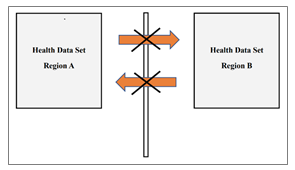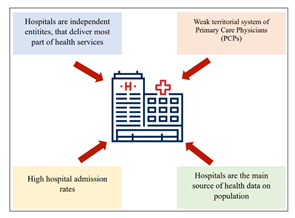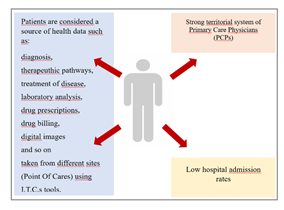A New Format for the Italian National Health System: from Hospital to Patient-Centric Care
Article Information
Matteo Maria Cati
University of Bologna, 2 Scaravilli Square, 40126 Bologna, Italy
*Corresponding author: Matteo Maria Cati. University of Bologna, 2 Scaravilli Square, 40126 Bologna, Italy.
Received: 10 July 2023; Accepted: 18 July 2023; Published: 24 July 2023
Citation: Matteo Maria Cati. A New Format for the Italian National Health System: from Hospital to Patient-Centric Care. Fortune Journal of Health Sciences. 6 (2023): 263-266
View / Download Pdf Share at FacebookAbstract
This paper explores the challenges and opportunities of implementing a groundbreaking data-driven and patient-centric approach in the Italian National Health System (N.H.S.). Italy's healthcare system is currently divided into regional subsystems, which leads to fragmented data sets and limited communication between regions. However, the recent Covid-19 pandemic has highlighted the urgent need for interoperability and data-driven solutions in healthcare. This paper emphasizes the paramount importance of collecting, updating, and storing population health data in interoperable repositories at regional, national, and international levels. It illuminates the intrinsic relationship between data-centricity and achieving patient-centric care. To accomplish this revolutionary shift, the paper proposes extensive digitization efforts, the introduction of cutting-edge telemedicine projects, and a strong emphasis on prevention. Additionally, the demographic trends of an aging population further reinforce the necessity of a data-driven approach to effectively manage chronic illnesses and optimize government spending on healthcare. In conclusion, this paper presents a compelling argument that, by wholeheartedly embracing a data-driven approach, fostering interoperability, and implementing necessary reforms, the Italian N.H.S. can overcome its current challenges and deliver unparalleled healthcare outcomes for its population.
Keywords
Public Health, Health Policy, Data Driven health care, Data-driven healthcare, Interoperability, Digital health information system, Population health dynamics
Article Details
1. Introduction
The Italian National Health System (N.H.S.) stands at the precipice of transformation, poised to revolutionize its healthcare delivery by adopting a groundbreaking data-driven and patient-centric approach. As structured by the Italian Constitution (II Part - V Title - Art. 131), Italy's healthcare system is currently divided into regional subsystems, with each region primarily focused on its own hospitals within their respective territories [1]. However, this territorial format has given rise to a fragmented healthcare landscape with limited communication and coordination between regional data sets on population health. The recent global upheaval caused by the Covid-19 pandemic has unmasked the inherent weaknesses of this format, highlighting the urgent need for interoperability and data-driven solutions in healthcare.
In response, the recent reform of the N.H.S. has emerged as a beacon of hope, emphasizing a transformative shift from a hospital-centric model to patient-centric care, propelled by accelerated digitization efforts, the integration of pioneering telemedicine projects, and a resolute focus on prevention at regional and national levels. This paper aims to shed light on two pivotal aspects: firstly, it highlights the paramount importance of data-driven healthcare systems by advocating for the collection, regular updating, and storage of population health data in interoperable repositories that facilitate seamless communication regionally, nationally, and internationally; secondly, it explores the profound cause-and-effect relationship between a data-centric approach and the realization of a patient-centric vision within healthcare systems. By analyzing strategies, implications, and potential benefits, this paper underscores the indispensable role that data plays in achieving patient-centric care.
2. Lack of Interoperability in the Italian Regional Healthcare Dataset
One of the most pressing issues that has surfaced during the Covid-19 outbreak is the lack of data interoperability in healthcare, a challenge not only faced by Italy but also many OECD countries. Despite some progress, the transition from the current hospital-centric format of the healthcare system to a patient-centric, data-driven healthcare system remains far from realized. The introduction of Electronic Health Records (E.H.R.s) stands as a significant milestone in the digitization of the Italian National Health System, serving as a testament to the ongoing transition towards a patient-centric, data-driven healthcare paradigm. E.H.R.s have proven to be instrumental in collecting diverse and comprehensive health data, encompassing the health histories of patients in each region.
However, a critical drawback persists—E.H.R.s lack interoperability across regions, resulting in critical information gaps during the pandemic. For instance, see Figure 1, information regarding the health history of a Covid patient in one region (Region A) was not accessible at the Point of Care (P.O.C.) in another region (Region B) where the patient was receiving care, underscoring the significance of interoperability for efficient and effective healthcare delivery [2]. The ability of different information and communications technology systems and software applications to communicate, exchange data accurately, effectively, and consequently, is essential for an efficient and comprehensive Digital Health Information System (H.I.S.) [3]. Therefore, achieving data interoperability is a "sine qua non" condition for a healthcare ecosystem that thrives on digital advancements.
3. Patient as a source of health data
There is no doubt that the pandemic has accelerated the usage of I.T.C. tools [4] in healthcare around the globe, particularly in Italy, where there is still much to do in terms of digital transition aimed at structuring a "Digital Health Information System (H.I.S.)" from the existing hospital-centric format of the Italian N.H.S., with patients at the center of the health ecosystem. Figure 2 depicts the main characteristics of a [5] hospital-centric N.H.S. system where:
- Hospitals are independent entities that deliver most of the health services and are the main source of health data on the population.
- In such a scenario, hospital admission rates are high, and there is a weak territorial system of Primary Care Physicians (PCPs).
On the contrary, Figure 3 shows that in a patient-centric health system [6]:
- Patients are considered sources of data such as diagnosis, therapeutic pathways, treatment of diseases, laboratory analyses, drug prescriptions, drug billing, digital images, and more.
- There is a strong territorial system of Primary Care Physicians (PCPs).
- Hospital admission rates are low.
The demographic characteristics of the Italian population and its consequences on population health dynamics and the evolution of government spending on health have reinforced the need for the transition of the Italian National Health System from the current state to a data-driven, more interconnected, and digitally managed health system. In particular, regarding population health dynamics, it can be highlighted that, based on the data and projections of the Italian National Bureau of Statistics [7], as of January 1, 2023:
- Individuals aged 65 years or more [8] represent more than 24.1% of the total population of 58,851,000 individuals, compared to 23.8% in the previous year, implying that one out of four individuals is at least 65 years old.
- Individuals aged 80 years or more [9] account for about 7.7% of the total population, compared to 7.6% in the previous year.
As of January 1, 2030:
- Individuals aged 65 years or more [10] will amount to approximately 15,995,350 individuals out of an estimated [11] population of 57,900,000 individuals, which is about 27.6% of the total estimated population.
- Individuals aged 80 years or more [12] will be equal to over 5,202,281 individuals out of an estimated [11] population of 57,900,000 individuals, which is about 8.98% of the total estimated population.
As of January 1, 2050:
- Individuals aged 65 years or more [13] will increase to approximately 19,852,317 individuals out of an estimated [14] population of 54,200,000 individuals, which is about 36.6% of the total estimated population.
- Individuals aged 80 years or more [12] will jump to approximately 8,308,765 individuals out of an estimated [14] population of 54,200,000 individuals, which is about 15.3% of the total estimated population.
Projections on the evolution of the Italian population show that, in the next 2-3 decades, the fraction of the overall population of individuals aged 65 years or more will increase by approximately 39.97%, and the fraction of individuals aged 80 years or more will increase by about 54.5%. Consequently, the fraction of the population of young people will decrease.
4. Conclusion
The Italian National Health System (N.H.S.) faces significant challenges due to the fragmentation of healthcare into locally managed regional subsystems and the lack of interoperability in the healthcare data set. The recent Covid-19 pandemic has exposed the urgent need for a patient-centric, data-driven approach to healthcare delivery. To overcome these challenges, the N.H.S. must prioritize the collection, updating, and storage of population health data in interoperable repositories that can communicate regionally, nationally, and internationally. Interoperability is crucial for the effective functioning of the health ecosystem, enabling accurate and efficient exchange of information across systems and organizational boundaries. The shift towards a patient-centric healthcare system that places patients at the center of the health ecosystem is essential. Patients must be recognized as valuable sources of health data, including diagnosis, treatment history, laboratory results, and more. Additionally, strengthening the territorial system of Primary Care Physicians (PCPs) and reducing hospital admission rates will contribute to a more efficient and cost-effective healthcare system.
Considering the demographic characteristics of the Italian population, with a significant increase in the elderly population in the coming decades, a data-driven approach becomes even more critical. Managing the growing number of chronically ill individuals with comorbidities and addressing the associated costs necessitates an interconnected and digitally managed health system. The transformation towards a data-driven and interoperable healthcare system is not without challenges. It requires substantial investments in technology, infrastructure, and human resources. However, the potential benefits are immense, including improved healthcare delivery, enhanced prevention strategies, and more efficient allocation of resources.
In conclusion, the Italian N.H.S. can overcome its current limitations and achieve patient-centric care by embracing a data-driven approach, fostering interoperability, and implementing necessary reforms. By leveraging the power of data, Italy can build a resilient and efficient healthcare system that meets the needs of its population now and in the future.
References
- Garattini L, Zanetti M & Freemantle N. The Italian NHS: What Lessons to Draw from COVID-19?. Appl Health Econ Health Policy 18 (2020): 463–466.
- Torab-Miandoab A, Samad-Soltani T, Jodati A, et al. Interoperability of heterogeneous health information systems: a systematic literature review. BMC Med Inform Decis Mak 23 (2023): 18.
- Epizitone A, Moyane SP, Agbehadji IE. A Systematic Literature Review of Health Information Systems for Healthcare. Healthcare 11 (2023): 959.
- Gaitán JA, Ramírez-Correa PE. COVID-19 and telemedicine: A netnography approach, Technological Forecasting and Social Change 190 (2023): 122420.
- Denita Cepiku, Filippo Giordano, Tony Bovaird & Elke Loeffler (2021) New development: Managing the Covid-19 pandemic—from a hospital-centred model of care to a community co-production approach, Public Money & Management 41 (2021): 77-80.
- Webber T, Santana JM, Vermeulen AF, Bowles JKF. Designing a Patient-Centric System for Secure Exchanges of Medical Data. In, et al. Computational Science and Its Applications – ICCSA 2020. ICCSA 2020. Lecture Notes in Computer Science 12254 (2020).
- ISTAT (Istituto Nazionale di Statistica - National Bureau of Italian Statistics) – Demographic indicators.
- ISTAT (Istituto Nazionale di Statistica - National Bureau of Italian Statistics) – Demographic Indicators. REPORT – 7th April 2023.
- ISTAT (Istituto Nazionale di Statistica - National Bureau of Italian Statistics) – Population projections (2023).
- ISTAT (Istituto Nazionale di Statistica - National Bureau of Italian Statistics) – Population projections (population aged 65 or more - 2030).
- ISTAT (Istituto Nazionale di Statistica - National Bureau of Italian Statistics) – Population projections (total estimated population in Italy - 2030).
- ISTAT (Istituto Nazionale di Statistica - National Bureau of Italian Statistics) – Population projections (population aged 80 or more - 2030).
- ISTAT (Istituto Nazionale di Statistica - National Bureau of Italian Statistics) – Population projections (population aged 65 or more - 2050).
- ISTAT (Istituto Nazionale di Statistica - National Bureau of Italian Statistics) – Population projections (total population estimated in Italy - 2050).
- ISTAT (Istituto Nazionale di Statistica - National Bureau of Italian Statistics) – Population projections. (population aged 80 or more - 2050).
- ISTAT (Istituto Nazionale di Statistica - National Bureau of Italian Statistics) – Population projections (population aged 80 or more - 2030).



